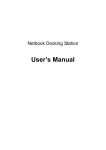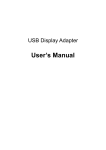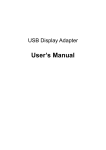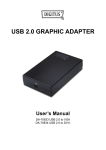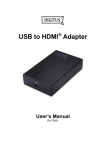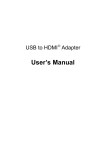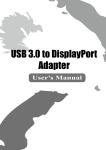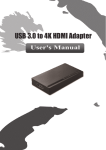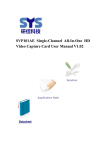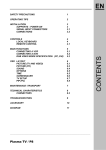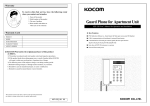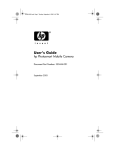Download Client Dock User`s Manual
Transcript
Client Dock User’s Manual Client Dock User’s Manual ABOUT THIS MANUAL This manual is designed for use with the Client Dock. Information in this document has been carefully checked for accuracy; however, no guarantee is given to the correctness of the contents. The information in this document is subject to change without notice. The manufacturer does not make any representations or warranties (implied or otherwise) regarding the accuracy and completeness of this document and shall in no event be liable for any loss of profit or any commercial damage, including but not limited to special, incidental, consequential, or other damage. SAFETY INSTRUCTIONS Always read the safety instructions carefully: Keep this User’s Manual for future reference Keep this equipment away from humidity If any of the following situation arises, get the equipment checked by a service technician: The equipment has been dropped and damaged. The equipment has obvious sign of breakage. The equipment has not been working well or you cannot get it to work according to the User’s Manual. COPYRIGHT This document contains proprietary information protected by copyright. All rights are reserved. No part of this manual may be reproduced by any mechanical, electronic or other means, in any form, without prior written permission of the manufacturer. TRADEMARKS All trademarks and registered trademarks are the property of their respective owners or companies. i Table of Contents Table of Contents 1. Introduction .......................................................................................................1 Features..............................................................................................................2 Package Contents...............................................................................................2 System Requirements.........................................................................................2 Front Panel .........................................................................................................3 Rear Panel..........................................................................................................4 Mounting Bracket .. .............................................................................................5 2. Installation .........................................................................................................7 A. Driver Installation............................................................................................7 On Windows XP/ Windows Vista ...............................................................7 On Windows 7 ...........................................................................................10 B. Connecting the Client Dock to Computer .....................................................13 C. Connecting Devices to the Client Dock ........................................................13 Connecting VGA Monitor .........................................................................................13 Connecting USB Devices ........................................................................................14 Connecting Microphone and Speaker/Headphones ................................................14 3. Using the Client Dock.......................................................................................15 USB 2.0 Ports ...................................................................................................15 Audio Ports .......................................................................................................15 Configuring Windows Audio Device...........................................................................15 Configuring Instant Messaging Software Audio Device .............................................16 Video Port .........................................................................................................17 Display Modes ...........................................................................................................17 Extend Your Windows Desktop to add-on Monitor (Default)......................................17 Mirror Your Windows Desktop ...................................................................................19 Be the Primary Monitor ..............................................................................................20 Adjusting Resolution, Color Depth and Refresh Rate................................................20 Disconnecting the Client Dock...................................................................................22 How Standby or Hibernate Mode Affects Devices Attached to the Client Dock.23 External Monitors.......................................................................................................23 Other Devices............................................................................................................23 4. Uninstalling the Drivers ..................................................................................24 ii Client Dock User’s Manual 5. Specifications..................................................................................................25 6. Regulatory Compliance ..................................................................................26 FCC Conditions ................................................................................................26 CE.....................................................................................................................26 WEEE Information ............................................................................................26 iii Client Dock User’s Manual 1. Introduction Client Dock enables you to connect directly to the server as a cloud client station with USB cable, which can connect up to 12M distance. With this Client Dock, you can just simply using a monitor, keyboard and mouse to work as a computer system without any extra device require. Moreover, Client Dock can support connect up to 6 or10 (Due to driver version) display screens which is an extremely cost effective application for the IT equipment investment. 1 Client Dock User’s Manual Features Extend display up to 12M from the computer Support Video resolution up to 1280x1024, 1440x900 (wide screen) Audio ports to connect to 2.1 stereo speaker and MIC Support up to 6 users (Default Driver) Support up to 10 users (Special driver for Windows Multipoint Server 2010) Compatible with USB 1.1/2.0 Specification Support Windows Multipoint Server 2010 Bus Power Package Contents Client Dock x1 Base Plate (Default) x1 VESA Mount Bracket (Optional) x1 CD (Driver and User’s Manual) x1 USB Cable x1 Quick Installation Guide x1 System Requirements Windows XP Professional SP3, Windows Vista, Windows 7 For a basic 2 workstation CPU: Intel Core 2 Duo 1.6 GHz or equivalent AMD processor. Memory: 2 GB of physical memory. For a 4-6 workstation CPU: Intel Core 2 Duo E8500 3.16 GHz 6MB L2 Cache Memory: 2 GB of physical memory. At least one PCI USB 2.0 host card. 2 Client Dock User’s Manual Front Panel LED Indicator 3 Client Dock User’s Manual Rear Panel Audio out Audio in 2 USB 2.0 downstream ports (A type female connector): For connection to USB peripherals. VGA video output port: For connection to a VGA monitor. USB upstream port: For connection to the USB port of the host computer. Power jack: For connection to power adapter. The Client Dock provides Bus Power Mode and Self Power Mode. 4 Client Dock User’s Manual Mounting Bracket Place VESA Bracket in position on back of monitor and attaches using 4 screws provided. The Client Dock comes with a base plate to make it self-standing. To disassemble the Client Dock, please unscrew the base plate. 5 Client Dock User’s Manual Please put Client Dock Station into Bracket. Finally, you can connect devices to Client Dock Station. 6 Client Dock User’s Manual 2. Installation A. Driver Installation On Windows XP/ Windows Vista To install the Driver 1. Insert the provided CD into your disc drive, locate and double-click the Run Autorun.exe file under E:\Driver where E is your disc drive letter. Note: If the installer program doesn’t run automatically, please locate and double-click on the Setup.exe file in the Driver folder to launch the setup program. If you encounter a User Account Control dialog box when attempting to install a program, enter an administrator password or click Allow to start the installation. 7 Client Dock User’s Manual 2. Please click I Accept after reading the statement of “SOFTWARE END USER LICENCE AGREEMENT FOR DISPPLAYLINK MIRROR DRIVER and DISPLAYLINK GRAPHICS ADAPTER SOFTWARE”. 3. Please wait while Windows configures DisplayLink Core Software. Your screens may temporarily go black or flash during this process. Note: You may need to restart your system for the configuration changes made to DisplayLink Graphics to take effect. 4. After the installation is completed, you will see the DisplayLink Manager Icon in 8 Client Dock User’s Manual System Tray that looks like a monitor as below. Click on the icon to bring up the menu. -Extend Mode: The screen is part of the extended desktop. -Mirror Mode: The screen copies the contents of the primary screen. -Off Mode: The screen is black. -Set as Main Monitor: The screen is the primary screen. -Notebook monitor off: The Notebook screen is black and the DisplayLink screen is the primary screen. *Actual strings depend on your operation system. These screen shots are from Windows XP SP2 and Windows Vista, it might vary slightly for each operation system. 9 Client Dock User’s Manual On Windows 7 To install the Driver: 1. Insert the provided CD into your disc drive and installer program will run automatically. Please click on Run Setup.exe to execute the install program. Note: If the installer program doesn’t run automatically, please locate and double-click on the Setup.exe file in the Driver folder to launch the setup program. If you encounter a User Account Control dialog box when attempting to install a program, enter an administrator password or click Allow to start the installation. 10 Client Dock User’s Manual 2. When you see the License Agreement screen prompted as below, please click on I Accept to install the software for USB display adapter... 3. Please wait while Windows configures DisplayLink Core Software. Your screens may temporarily go black or flash during this process. Note: You may need to restart your system for the configuration changes made to DisplayLink Graphics to take effect. 11 Client Dock User’s Manual 4. After the installation is completed, the following Window will pop up. You can change the appearance of your displays through the Window. Moreover, additional controls are available in Windows 7: Orientation (Portrait, landscape, rotated portrait, rotated landscape) 5. To control the behavior of an attached DisplayLink device (or screen), it is possible to use Windows Key+P to display a menu (and cycle through it) to allow: Disconnect Projector, Duplicate, Extend, Projector Only. *Actual strings depend on your operation system. These screen shots are from Windows 7 and might vary slightly for each operation system. 12 Client Dock User’s Manual B. Connecting the Client Dock to Computer 1. Plug the square end of the USB cable into the USB upstream connector at the back of the Client Dock. 2. Plug the other end of the USB cable into an available USB 2.0 port on your computer. Upon the USB connection, your computer will automatically complete the remaining installation, including installing Windows built-in drivers for the USB hub. A pop-up message will appear in the notification area indicating the installation status. Wait for the final message indicating the driver software installation is successful. Then the Client Dock is ready for use. C. Connecting Devices to the Client Dock Now the installation is complete. You can connect the peripherals/monitor to appropriate ports on the Client Dock as required. If required, you can connect and disconnect the peripherals/monitor any time without disconnecting the Client Dock from the USB port on your computer. Connecting VGA Monitor ◆ For VGA model: Use a VGA cable (not provided) to connect the VGA jack to a monitor equipped with VGA input jack. Upon the connection it’s normal that the screen flicks black a couple of times. Once the connection is done, an extended screen will appear on the add-on monitor. Sometimes it takes time for the add-on monitor to show the video. Please wait for while. For Windows Vista, if the add-on monitor has been blank for a while, please reboot your system again. 13 Client Dock User’s Manual To change the display mode, see next chapter for instructions. Connecting USB Devices Connect your USB devices to the USB ports on the Client Dock. If your USB device, such as a printer or optical drive, etc., came with its own AC adaptor, make sure that it is plugged into the device and a working electrical outlet. Connecting Microphone and Speaker/Headphones To connect your speaker/headphones, insert the plug to the green hole of the Client Dock. To connect a microphone, insert the plug to the pink hole of the Client Dock. 14 Client Dock User’s Manual 3. Using the Client Dock USB 2.0 Ports The two USB ports on the docking station function just like the ports on a USB hub. Just connect any USB device to the docking station’s USB ports when required. All the two USB ports provide power when the computer is either off, suspended or hibernated. This means you can use the USB port for power charging purpose. The USB port supports hot-plug feature. You may plug and unplug an USB device from the docking station at any time when required. Audio Ports Prior to using the speaker/microphone connected to the docking station, you have to correctly configure your application to use USB (Multimedia) Audio Device, i.e., the audio components of the docking station. When the docking station is connected to your computer, the audio devices named USB (Multimedia) Audio Device are automatically installed and may override Windows default audio settings. The most obvious effect is that your original music playback will be re-directed to the speaker connected to the docking station. However, it’s possible that users may want to use original sound card for music playback and use the docking station’s audio ports for chatting via instant messaging software (such as MSN messenger, Yahoo messenger or Skype). In such cases users have to manually configure required audio device for each application. Configuring Windows Audio Device To specify a sound device for music playback in Windows, open Control Panel and double-click the sound or audio icon. Then select a desired device in the playback section. If you want to use your original sound card for music playback, make sure to select it instead of USB (Multimedia) Audio Device. 15 Client Dock User’s Manual Configuring Instant Messaging Software Audio Device To chat via instant messaging software using the headphone and microphone connected to the docking station, make sure the instant messaging software, such as MSN messenger, Yahoo messenger or Skype, are configure to use USB (Multimedia) Audio Device as the audio in and out devices. 16 Client Dock User’s Manual Video Port Display Modes There are several ways you can utilize the monitor attached on the docking station. The add-on monitor can be configured to use either “mirror mode”, “extended mode” or be the primary display as described in this section. Extend Your Windows Desktop to Add-on Monitor (Default) In this so-called “extended mode”, your display will be spread over the add-on monitor(s). This mode allows you to perform multiple tasks more effectively without overlapping windows. Extended mode is the default setting. To set up the video component to use or restore extended mode, follow these steps: 1. Position the mouse anywhere on your computer desktop, right-click and select Screen Resolution on Windows 7, Personalize > Display Settings on Windows Vista or Properties > Settings on Windows XP/ Windows 2000. 2. In the Display drop-down menu, select the option with the string “DisplayLink Graphics Adapter”. 3. Check the Multiple Displays> Extend these displays on Windows 7, Extend the desktop onto this monitor box on Windows Vista or Extend my Windows desktop onto this monitor box on Windows XP/ Windows 2000. 4. Drag the icons in the window at the top of the screen to match the physical arrangement of your primary monitor and add-on monitor. 17 Client Dock User’s Manual The add-on monitor connected to the docking station may be identified as either "2" or “3”, depending on your computer, although there may not be a total of 3 screens connected. 5. Click OK to close the settings screen. Once the setting is done, to use your extended desktop, simply drag and drop your open windows over to your second monitor. However, note that some applications may not support display on the extended desktop. Cursor disappeared ? If you’re in extneded mode but the add-on monitor is not connected, the desktop still pans to the add-on monitor and it’s possible that your cursor has moved to the extended desktop so that you cannot find it on the primary display. To solve the problem in such a case, connect the add-on monitor to the docking station or keep moving your mouse to try or unplug the docking station first to restore the cursor. 18 Client Dock User’s Manual Video and DVD Playback in Extened Mode On Windows Vista with extended mode, it’s suggested that you run video or DVD playback programs on your primary monitor instead of the add-on monitor to ensure the playback performance. Mirror Your Windows Desktop This mode is referred to as “mirror” or “clone” mode. In this mode, your original screen (the primary display) will be mirrored to the add-on monitor. In mirror mode, the video component will automatically select the settings (screen resolution, color quality and refresh rate) for the add-on monitor. But you can manually adjust the settings as required. However, the settings of the add-on monitor are limited by that of the primary monitor. For example, even though your add-on monitor supports a resolution of up to 1680x1050, you can only configure it to use 1280x1024 due to the primary monitor only supports a resolution of up to 1280x1024. If you change the video output to extended mode and then want to switch back to mirror mode, follow these steps: 1. Position the mouse anywhere on your computer desktop, right-click and select Screen Resolution on Windows 7, Personalize > Display Settings on Windows Vista or Properties > Settings on Windows XP/ Windows 2000. 2. In the Display drop-down menu, select the option with the string “DisplayLink Graphics Adapter”. 3. Check the Multiple Displays> Duplicate these displays on Windows 7, uncheck the Extend the desktop onto this monitor on Windows Vista or Extend my Windows desktop onto this monitor on Windows XP/ Windows 2000. 4. Click OK to close the settings screen. 19 Client Dock User’s Manual Be the Primary Monitor To make the add-on monitor the primary display: 1. Position the mouse anywhere on your computer desktop, right-click and select Screen Resolution on Windows 7, Personalize > Display Settings on Windows Vista or Properties > Settings on Windows XP/ Windows 2000. 2. In the Display drop-down menu, select the option ends with DisplayLink Graphics Adapter. 3. Check the This is my main monitor box on Windows Vista / Windows 7 or Use this device as the primary monitor box on Windows XP/ Windows 2000. On some PCs and laptops it is necessary to disable the main display (i.e. uncheck the Extend the desktop onto this monitor or Extend my Windows desktop onto this monitor box for the main display) as part of the same settings change. 4. Click OK to close the settings screen. The add-on monitor stays primary if the PC enters hibernate or suspend mode or is rebooted. If the add-on monitor is unplugged, the main display becomes primary again. Adjusting Resolution, Color Depth and Refresh Rate There are three components that make up the screen mode: Resolution: In common usage, this refers to the number of pixels displayed on screen horizontally and vertically. Color Depth: This defines the number of different colors that can be shown on the screen at the same time. Refresh rate: Measures the speed that the entire screen is rescanned. Higher frequencies reduce flicker. Some monitors advertise the supported modes through the video connector. If this is the case, the video component identifies the supported modes from the monitor. If the monitor does not advertise the supported modes, the video software chooses a set of common screen modes for the monitor. 20 Client Dock User’s Manual The software supports the modes listed below. Color Depth Resolution 640x480 800x600 1024x768 1280x960 1280x1024 1360x768 1366x768 1368x768 1400x1050 1440x900 Refresh rates available at Refresh rates available at 16 bit color quality 32 bit color quality 60 72 75 85 60 72 75 85 56 60 72 75 85 56 60 72 75 85 60 70 75 85 60 70 75 85 60 85 60 85 60 75 60 75 60 60 50 60 50 60 60 60 60 75 85 60 75 85 60 60 About the resolutions and refresh rates available to users The resolutions and refresh rates available to the user through Windows are a comprise of the support from the following elements: ■ The video component of the docking station ■ The primary monitor and the add-on monitor ■ The primary video card on your computer and installed drivers If cloning the primary display, the video component will try to use the preferred monitor mode. In some cases, this may not be the most appropriate mode for the cloned desktop. It is recommended that the primary display resolution be changed to closer match the default resolution of the add-on monitor. To configure the three components (resolution, color depth and refresh rate) of a screen mode, follow these steps: 1. Position the mouse anywhere on your computer desktop, right-click and select Screen Resolution on Windows 7, Personalize > Display Settings on Windows Vista or Properties > Settings on Windows XP/ Windows 2000. 2. In the Display drop-down menu, select the option ends with DisplayLink Graphics Adapter. 21 Client Dock User’s Manual 3. To change the screen resolution or color quality, select those options on the screen. Be sure to select one of the supported resolutions and color quality numbers in the table above. For an add-on monitor, you can also select any resolution or color quality supported by that monitor. 4. To change the refresh rate, click Advanced… and then click Monitor. 5. Select a refresh rate from the Screen refresh rate drop-down list and then click Apply. 6. Click OK to close the settings screen. Disconnecting the Docking Station If the docking station is unplugged from the computer, the add-on monitor goes blank. All windows and icons move to the primary screen. On reconnection of the docking station, the docking station returns to the same mode as it was before disconnection. However, windows and icons that were previously on the screen will not be moved back. 22 Client Dock User’s Manual How Standby or Hibernate Mode Affects Devices Attached to the Docking Station External Monitors When the docking station is connected to a computer and an external monitor, if the computer goes into standby or hibernate mode, the external monitor display goes blank. When the computer returns to an active state, the external monitor display keeps the same settings it had before the computer went into standby or hibernate mode. However, if the add-on monitor was set for extended mode, windows that were previously on the external monitor will not move back to that secondary monitor. Also, if the add-on monitor is in extended mode and the computer requires a login after standby or hibernate mode, the login screen appears on the primary computer monitor, not the external monitor. If the computer is shut down, restarted and logged in, again the add-on monitor returns to the same mode as it was before shutdown. Other Devices If another device is connected to a port on the docking station and the computer goes into standby or hibernate mode, that device will not function. 23 Client Dock User’s Manual 4. Uninstalling the Drivers Uninstalling the Driver Please take these steps to uninstall Drive: 1. Open the Control Panel and double-click Uninstall a Program on Windows 7, Programs and Features on Windows Vista or Add or Remove Programs on Windows XP. 2. Select DisplayLink Graphics…and click Uninstall or Remote 3. Click Yes to confirm the removal. 4. Click Yes to restart your computer. You can also disconnect the video connection now. 24 Client Dock User’s Manual 5. Specifications General Host Interface USB 2.0 Ports and Connectors Upstream 1 x Upstream USB 2.0 Port (Type B female Connector) USB Hub Downstream 2 x Downstream USB 2.0 Port (Type A female connector) Video 1 x VGA Port (Female Connector) Audio 1 x Audio in (3.5 mm stereo Jack Female) 1 x Audio out (3.5mm stereo Jack Female) LED Power LED (Blue) On: Power is supplied to the Client Dock. Off: No power is supplied to the Client Dock. Physical Specifications Housing Material Plastic(ABS+PC) Dimensions 66.9mm(L) x 30mm(W) x 142.05mm(H) Weight Approximately 230g (including base) * Specification is subject to change without further notice. 25 Client Dock User’s Manual 6. Regulatory Compliance FCC Conditions This equipment has been tested and found to comply with Part 15 of the FCC Rules. Operation is subject to the following two conditions: (1) This device may not cause harmful interference (2) This device must accept any interference received. Including interference that may cause undesired operation. CE This equipment is in compliance with the requirements of the following regulations: EN 55 022: CLASS B WEEE Information For EU (European Union) member users: According to the WEEE (Waste electrical and electronic equipment) Directive, do not dispose of this product as household waste or commercial waste. Waste electrical and electronic equipment should be appropriately collected and recycled as required by practices established for your country. For information on recycling of this product, please contact your local authorities, your household waste disposal service or the shop where you purchased the product. 26

































